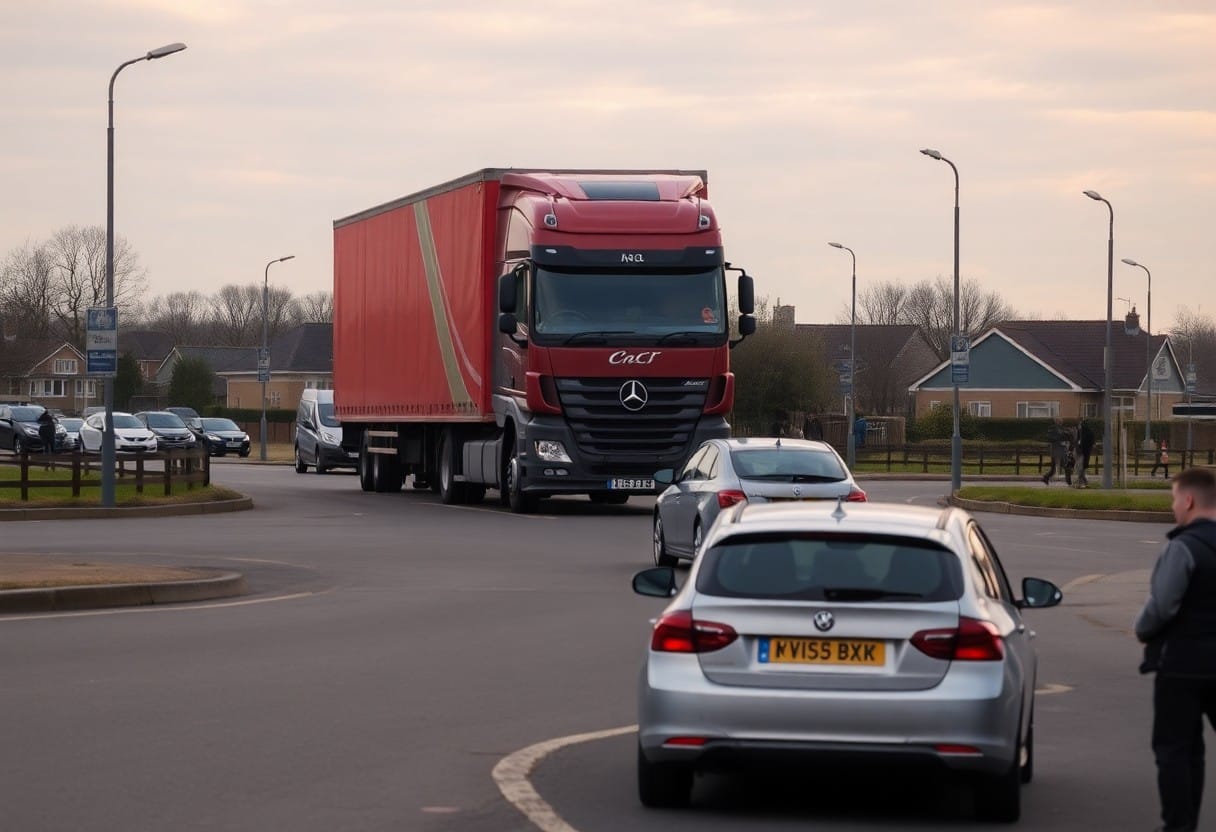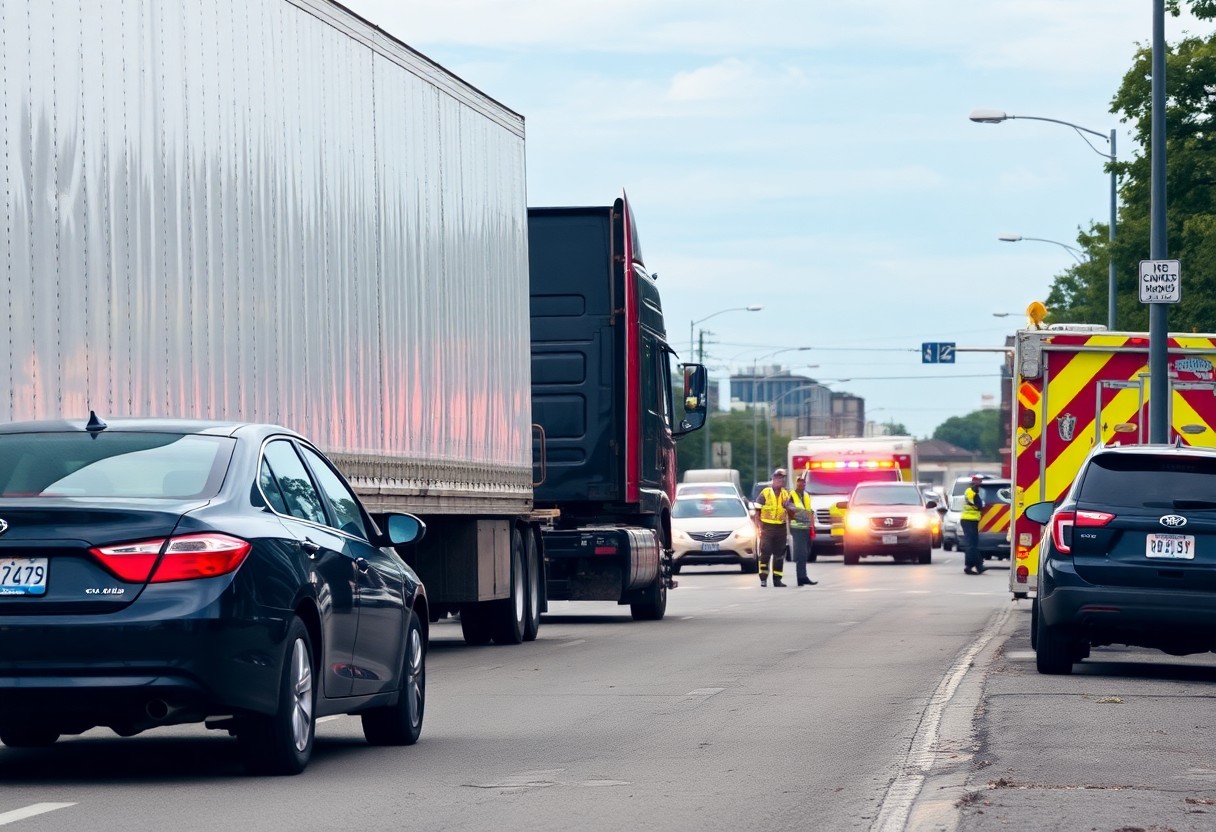With an increase in truck traffic on the roads of Mobile, understanding blind spots is necessary for your safety. These areas where visibility is limited can lead to dangerous situations, often resulting in serious accidents. Truck drivers have larger blind spots compared to other vehicles, making it challenging for them to see smaller cars or pedestrians. By being aware of these blind spots and adapting your driving habits, you can significantly reduce the risk of accidents and contribute to safer roads for everyone.

Understanding Blind Spots
For many drivers, especially those operating large vehicles like trucks, blind spots can represent a significant danger on the road. These areas are zones around the vehicle that are not visible to the driver through mirrors or direct line of sight, increasing the risk of accidents during lane changes, turns, or when reversing.
Definition of Blind Spots
Understanding blind spots involves recognizing those invisible zones that surround your vehicle. These blind spots vary by vehicle type and dimensions, making it imperative for truck drivers to be aware of their specific blind areas to maintain safety on the road.
Types of Blind Spots in Trucks
Between the various types of trucks, blind spots differ significantly, impacting your ability to navigate safely. Below are the main types of blind spots you should be aware of:
| Location | Blind Spot Description |
| Front of the Truck | Obstructed view when stopping or turning, especially in tight spaces. |
| Back of the Truck | Blind area directly behind, posing risks while reversing. |
| Side of the Truck | Large zones on both sides, particularly noticeable on longer trucks. |
| Near the Wheel Wells | Smaller patches adjacent to the wheels are often overlooked. |
| Height Blind Spot | A view obstruction due to the truck’s raised height, affecting visibility. |
Knowing the specific types of blind spots in trucks will help you enhance your situational awareness while driving. This understanding is important for preventing accidents and ensuring a safer driving environment for everyone on the road.
The confusion surrounding blind spots can lead to dangerous situations if not properly understood. Awareness of your truck’s blind spots enables you to anticipate the actions of other drivers and pedestrians, minimizing potential risks. Each type of blind spot poses unique challenges, as outlined below:
| Blind Spot Type | Impact |
| Front Blind Spot | Increases the risk of colliding with obstacles during turns. |
| Rear Blind Spot | Potential accidents while backing up without proper awareness. |
| Side Blind Spot | Increases the likelihood of clipping vehicles or cyclists. |
| Wheel Well Blind Spot | Neglecting this area could lead to accidents with nearby vehicles. |
| Height Blind Spot | Obscured views can lead to misjudgments while navigating underpasses. |
Knowing these types of blind spots helps you improve your driving strategy, enhancing safety for you and others on the road. Staying informed about where these blind spots are located is a vital step in accident prevention.
Statistical Overview of Truck Accidents
Assuming you are aware of the significant impact trucks have on road safety, it’s important to note that truck accidents comprise a substantial portion of all vehicular incidents. In Mobile, the percentage of accidents involving large trucks is alarmingly high, contributing to severe injuries and fatalities. By understanding these statistics, you can better appreciate the risks associated with truck driving, particularly in densely populated urban areas.
Frequency of Blind Spot-Related Accidents
An overwhelming number of truck accidents occur due to blind spots, where drivers cannot see other vehicles in critical areas around their trucks. These blind spots can easily lead to collisions, especially during lane changes or turns when a truck driver might not be aware of a smaller vehicle adjacent to them. Recognizing the frequency of these incidents can help raise awareness about the dangers of truck blind spots.
Impact of Blind Spots on Overall Accident Rates
Across various studies, the data reveals that blind spots significantly contribute to the overall rate of truck accidents. When you consider that a staggering proportion of truck-related crashes stem from visibility issues, it’s clear that addressing these blind spots should be a top priority for both truck drivers and motorists. Your understanding of these dangers can help in avoiding potential accidents.
Further analysis indicates that blind spots account for over 30% of all truck-related accidents, underscoring the need for heightened awareness and strategic safety measures. Vulnerable road users, such as cyclists and pedestrians, face increased risks in scenarios where trucks are involved, particularly during turns and lane changes. By prioritizing education and developing new technologies to enhance visibility, you can contribute to a collective effort aimed at reducing these alarming statistics and making the roads safer for everyone.
Factors Contributing to Blind Spot Incidents
While numerous elements contribute to blind spot incidents in truck accidents, the most significant include:
- Limited visibility in certain areas
- Large vehicle size
- Inadequate mirror systems
- Poor road conditions
- Driver distraction
After considering these factors, it’s clear that addressing them is crucial for enhancing road safety.
Driver Awareness and Training
Between effective training programs and heightened driver awareness, addressing blind spots significantly reduces the risk of accidents. Insightful education equips truck drivers with crucial skills to manage their surroundings, focusing on understanding the limitations posed by their vehicles. Furthermore, fostering habits that promote vigilance can greatly impact road safety.
Truck Design and Safety Features
Driver awareness is vital, but so is the design of your truck. Enhanced design features such as larger side mirrors, blind-spot monitoring systems, and sensor technologies can significantly reduce the chances of accidents caused by blind spots. Features like rearview cameras and additional visual aids allow you to better navigate your environment. Properly designed trucks not only help locate surrounding vehicles but also improve overall driver confidence.
This emphasis on improved truck design is fundamental. The latest safety features are engineered to minimize risks associated with blind spots. For instance, advanced collision avoidance systems can help alert you to potential dangers in hard-to-see areas. Moreover, ensuring that your truck is equipped with cutting-edge technology helps you stay informed about your surroundings, significantly lowering the likelihood of accidents. By investing in such safety advancements, you foster a safer driving experience for both yourself and others on the road.
Best Practices for Avoiding Blind Spot Accidents
Your awareness and proactive measures can significantly reduce the risk of blind spot accidents. Always ensure that you check your mirrors regularly, position your vehicle appropriately on the road, and maintain a safe following distance. By being mindful of your surroundings and anticipating potential hazards, you can improve your driving safety in areas shared with trucks and other large vehicles.
Defensive Driving Techniques
Above all, practicing defensive driving is vital for avoiding blind spot accidents. This includes being on high alert for any sudden movements from surrounding vehicles, especially trucks, and adjusting your speed accordingly. Always be prepared to react to the unexpected and avoid distractions that could take your focus away from the road.
Technological Aids and Innovations
Best practices also include utilizing technological advancements designed to enhance safety. Many trucks are now equipped with blind spot detection systems that alert drivers to obstacles in their path, making it safer for everyone on the road.
To optimize safety further, you should consider using blind-spot monitoring systems in your vehicles, which effectively minimize the risk of accidents by detecting vehicles that are not visible in your mirrors. Additionally, technologies like rearview cameras and lane departure warnings can provide you with vital information about your surroundings. By embracing these innovations, you not only enhance your safety but also contribute to a safer driving environment for everyone.
Regulatory Measures and Guidelines
Despite existing efforts to address safety concerns, blind spots remain a significant factor in truck accidents in Mobile. Effective regulatory measures and stringent guidelines are vital to minimize risks associated with these blind spots. Enhanced training programs and vehicle design improvements could play a substantial role in protecting all road users.
Current Regulations on Truck Safety
Below are some key regulations aimed at maintaining truck safety: The Federal Motor Carrier Safety Administration (FMCSA) mandates specific safety measures, including regular inspections and maintenance, driver qualifications, and hours of service requirements. However, enforcement and compliance issues continue to challenge these regulations.
Recommendations for Policy Improvements
Across the board, enhancing policy measures surrounding truck safety can significantly reduce accidents. Suggestions include mandatory blind spot detection systems, regular safety training for drivers, and stricter penalties for non-compliance with existing regulations.
And, to create a safer driving environment, you should advocate for mandatory installation of blind spot monitoring technology in all commercial trucks. Implementing regular safety training programs can ensure your drivers understand the risks associated with blind spots. Additionally, increasing community awareness about sharing the road with trucks can lead to better overall road safety. By addressing these recommendations, you can contribute to reducing truck-related accidents and enhancing safety standards across Mobile.
Case Studies of Blind Spot Accidents
Keep in mind the alarming statistics regarding blind spot accidents involving trucks. Here are some case studies that highlight the severity of this issue:
- In 2020, 25% of truck accidents in Mobile were attributed to blind spots.
- A survey revealed that 70% of truck drivers reported near-miss incidents due to blind spots.
- Since 2019, blind spot accidents have increased by 15% annually in urban areas.
- Data shows that 80% of pedestrian fatalities in truck accidents involve blind spots.
Notable Incidents in Mobile
Incidents involving blind spots in Mobile have highlighted the need for increased awareness. One notable example includes a collision where a truck turned right, failing to notice a cyclist in its blind spot, resulting in serious injuries. Another case involved a multi-vehicle pileup caused when a truck driver switched lanes without checking their mirrors thoroughly.
Lessons Learned from Past Accidents
Among the lessons from past accidents, it becomes evident that education and awareness are non-negotiable. Drivers need to understand the importance of checking blind spots before making lane changes. Studies show that better training can reduce blind spot incidents considerably.
Hence, proactive measures such as implementing advanced safety systems, utilizing blind spot detection technologies, and conducting regular training sessions can significantly enhance safety. You must prioritize awareness of your surroundings and adopt best practices to mitigate risks associated with blind spots. By doing so, you not only protect yourself but also contribute to safer roads for everyone.
Final Words
Now that you understand how blind spots can significantly contribute to truck accidents in Mobile, it’s imperative to stay vigilant while driving. Knowing where these blind spots are and how they affect larger vehicles can enhance your safety and that of others on the road. Always be cautious and aware of your surroundings, particularly when sharing the road with trucks. Being informed empowers you to make safer decisions while driving, ultimately reducing the risk of potential accidents.



















